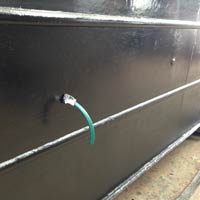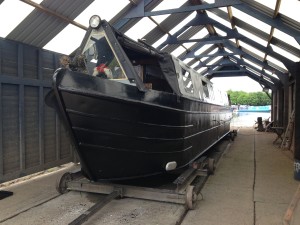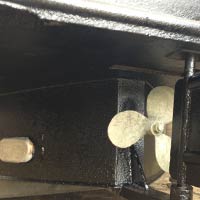One of the most important things to consider, especially if you are thinking of living on a narrowboat, is the amount of time and money needed to maintain your vessel in good condition. Just like a land based dwelling, you will need to consider the exterior paintwork on a boat and in particular, the area of the hull beneath the waterline.
Whilst the majority of paintwork on the superstructure of a boat is accessible all of the time, the condition of the lower part of the hull will only become apparent once the boat is out of the water.
A number of boatyards offer dry dock facilities, but the way the boat leaves the water can vary.
Some yards have a tractor and trolley system, where the boat is floated over a couple of short, wheeled trollies, and then pulled up a ramp by a tractor unit. I have used boatyards where the boat is then left on the ramp (not very comfortable if you continue to live on the boat while you carry out your work) and boatyards where the boat is pulled onto level ground – a far better arrangement.
Some boatyards use a crane to lift the boat from the water (a heart stopping moment for most owners) and in a few isolated cases, some dry docks lie alongside a flight of locks, and can be emptied in the same way as a lock to deposit the boat onto brick built piers, allowing it to be worked on once the water has drained.
Whichever method is used, the boat owner needs to take the cost of pulling the boat from the water into their calculations – it isn’t just the cost of paint needed to do the job.
Once out of the water, the narrowboat owner will need to jet wash the hull to remove weed etc. (usually another cost – mounts up, doesn’t it?) before allowing the boat to dry, prior to applying any paint. At this point, it’s a good idea to examine the anodes (or adenoids as my wife calls them!)
The proper name for these vital lumps of metal is a ‘Sacrificial Anode’ and they form an important part in the boat’s battle against corrosion. Put bluntly, these have a higher electrochemical value than steel, which means they corrode away faster. Even in canal water, a boat acts a bit like a battery – a tiny voltage is created because of an electric current forming between different metals under the water, for example, the steel hull and the bronze prop. This would normally cause the steel to corrode, but as the name implies, the sacrificial anode will be eaten away first.
It is for this reason that anodes should never be painted over when painting the lower part of the hull – it would prevent them working. A 50” boat will normally require 4 anodes, 2 each side at the front and rear, although I tend to opt for a further anode each side, about half way down the boat’s length.
Once the hull is dry, the narrowboat owner needs to apply paint to the hull. This is usually bitumen based paint, which is why the practice of applying the paint is often referred to as ‘blacking’. When cold, this stuff is like trying to apply tar, so if you are painting in winter, a good tip is to stand the paint tin in a bucket of hot water first, to allow the paint to become runnier. One of the reasons bitumen based paint is used is that if it receives a knock or bump, it has a tendency to smear rather than chip off, so continues to give a good degree of protection.

It’s a good idea to use an old bit of hose to prevent water dribbling down your new paint from drainholes
The paint can be applied by brush, (if you are a masochist) or by a combination of brush and roller, which apart from being faster, also gives greater coverage. Try to apply as many coats as possible while the boat is out of the water – it may be some time before it comes out again. I have often been asked how often a boat should be ‘blacked’. There is no easy answer to this, as it will depend on how the boat is used. I know of some boatyards who recommend painting every two years, and some maintenance books that suggest every five years. On that basis, every three to four years should suit most narrowboat owners.
Don’t forget to paint the Uxter plate – the horizontal part of the underside of the boat where your engine sits, as well as the weed hatch. But DO NOT FORGET to fit the hatch back again, before being put back in the water, as the engine compartment could fill with water the first time you turn on the engine and put the prop in gear.
It is not normally the case that the baseplate of the boat requires blacking – its depth below the water usually means that corrosion is less likely to occur – besides which, a combination of shallow water and debris on the bottom of the canals often renders this a bit of a futile exercise. The choice on whether to do so is down to the individual.
If you are being pulled out or returned to the water by ramp, you may be asked to run your engine by the tractor operator, as in some cases, the exhaust point on your boat may momentarily dip below the water line, before the boat starts to right itself. Running the engine should prevent any water running back through the exhaust system.
I have found that a ‘proper’ blacking session takes a long weekend – that is, the boat gets pulled from the water on a Friday morning, is worked on all weekend, and returned to the water on a Monday, and most boatyards have a price that accommodates this practice.
In summary, its hard work, its dirty work, and you will probably ache for a few days after, but by taking the time to carry out this vital piece of maintenance, you will extend your boat’s life by many years.



